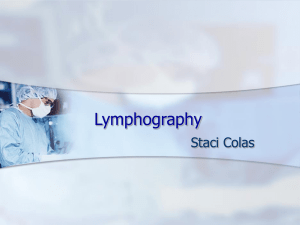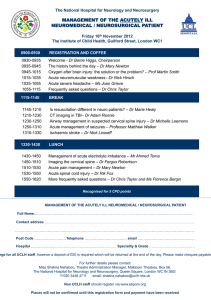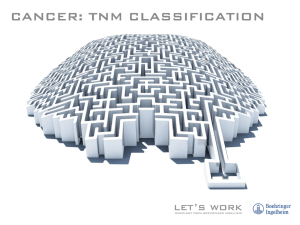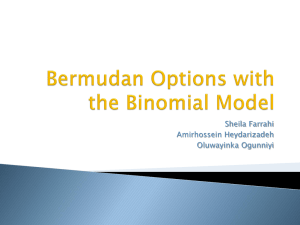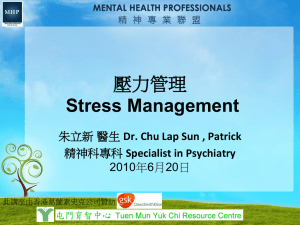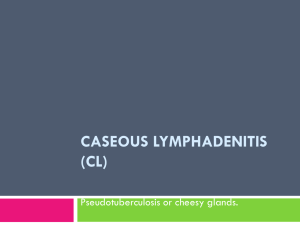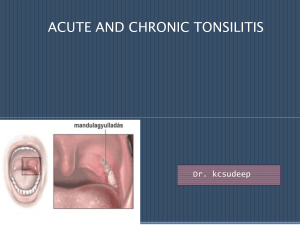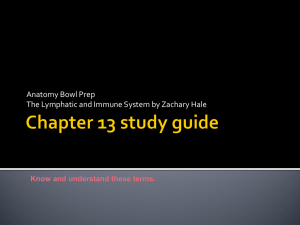Acute dyshagia and odynophagia
advertisement
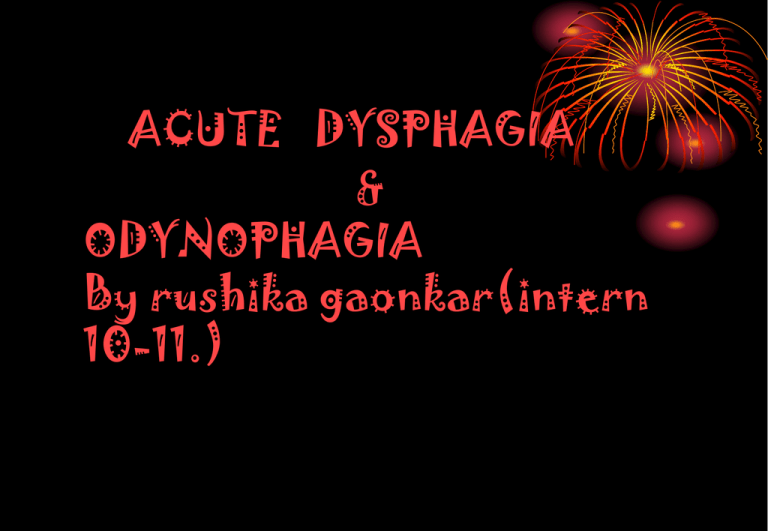
ACUTE DYSPHAGIA & ODYNOPHAGIA By rushika gaonkar(intern 10-11.) The following conditions present acute dysphagia as a symptom. 1. Adhijivha : Prabandhane adho jivhaya shopho jivhaagra sannibha Saankurah kaphapittaasrayhi laaloshaast ambhavan kharah Adhijivha sarukkandurvaakyahaar vidyat krut. Va.U.21/34,35 On the dorsal surface of the tongue, a swelling of the shape of tongue develops due to kapha, pitta and rakta dushti. It contains ankur, excessive salivation, burning sensation, pain and kandu(itching) are also present. According to Acharya Kashyapa, aruchi, glani (fatigue), stambha and kapola shotha are also present. It is rough to touch. There is difficulty in deglutition and speech. Sadhyasadhyata: It is asadhya in pakwa awstha. Chikitsa: Unnamya jivhamaakrushtam badishena adhijivhikam.-Va.U.22/45 Chedayen mandalagrena tikshnoshnergharshanadi cha. Tikshnashcha nasyadayah –A.Sa.U.26/190 Patient is asked to elevate the tongue or the vaidya elevates it with the help of badish yantra.Then with the help of mandalagra shastra,chedan of adhijivha is done. After chedan the vrana is rubbed with tikshna and ushna churna and tikshna nasya is given. Ranula: It is a retention cyst in the floor of the mouth arising from the minor salivary glands. It may penetrate the mylohyoid muscle and present in the neck (Plunging ranula) Clinical features: It presents as a bluish, translucent cyst in the floor of the mouth, resembling the frog belly. Treatment: Ranula confined to the mouth should be excised. Plunging ranula should be marsupialised and the sublingual gland excised. 2. Tundikeri:- (Acute Tonsillitis) Shophah sthulastodadahaprapaki praaguktabhyam tundikeri mata tu. –Su.Ni.16/42 Hanusandhyashritah kanthe kaarpaasiphala sannibha. Picchilo mandaruk shophah kathinastundikerika. –Va.U.21/47 The shotha occuring at talu region due to kapha and rakta is called tundikeri. Toda, daha, paka are the symptoms. It is as big as the seed of cotton. Acharya Vagbhata has called it kantha roga and stated its site to be the inner side of jaw. The shotha is hard, slimy to touch with slight pain and fever. 3. Adhrusha Shophah stabdho lohitastaludeshe raktaajneyah so adhrusho rugjwaraadhyah. –Su.Ni.16/42 Chikitsa : shastrakarma The reddish shotha occuring at taalu pradesh due to rakta is Adhrusha.It is stabdha, slow spreading and associated with pain and fever Acute Tonsillitis: It is an infection of the tonsils occurring frequently up to 15yrs of age, but without any age bar. Both sexes are equally affected. Predisposing factors: Endogenous : Pre-existing upper respiratory tract infection Pre-existing chronic tonsillitis. Post nasal discharge due to sinusitis. Residual tonsillar tissue after tonsillectomy. General lowering of the resistance. Exanthemata Blood dyscrasias : Very low resistance due to diseases like agranulocytosis, leukaemias, or hodgkins disease may cause gangrenous tonsillitis. Exogenous: 1. Ingestion of cold drinks or cold foods causes direct infection or lowers the resistance by vasoconstriction. 2. Contagion: The infection may be contacted from other individuals having infection . 3. Pollution and crowded ill-ventillated environment. 4. Imbedded foreign body. Causative organisms: Respiratory gram positive cocci like streptococcus, pneumococcus and diphtheroid organisms. Haemolytic streptococcus has a special prediliction. It may be a viral infection Pathological types : 1. Acute Parenchymatous Tonsillitis : The tonsils are enlarged & congested. 2. Acute Follicular Tonsillitis : The crypts are studded with pus & stand out as multiple yellow spots on the red congested tonsils. Symptoms : 1. Raw sensation in the throat. 2. Pain in the throat, aggravated by swallowing, may be referred to ears. 3. Refusal to eat children refuse to eat because of odynophagia. 4. Voice is thick & muffeled due to thick secretions & impeded movements of the palate. 5. Jugulodigastric nodes are enlarged & painful. 6. Malaise, fever, headache & tachycardia may be present. 7. Duration is usually 4 to 6 days. Signs : 1. Tonsils become congested & swollen. 2. Secretions increase & become tenacious. 3. Movements of palate become impeded due to pain. 4. Halitosis may be present. 5. Jugulodigastric nodes get enlarged & tender. Treatment : 1. Bed rest & soft diet are advised. 2. Antibiotics : Acute tonsillitis responds promptly to most antibiotics as well as sulphonamides. Mild infection may resolve without antibiotics. 3. Analgesics are advised to reduce pain & pyrexia. 4. Warm saline gargles are soothing. 5. Lozenges with local anaesthetic action may be comforting 4. Rohini Vataja Rohini:-(Diphtheric Pharyngitis) Hanushrotrarukkari. –Va.U.21/42 Vatatmakopdravagaadhyukteti vatatmaka upadravah. Kampavinaamstambhaadayasteyratishayamanugata –Madhukosha Ma.Ni.Pa 261 On all 5 sides of tongue, painful mamskur develop. They cause obstruction of the throat & dysphagia. There is talu shosha, there is pain in ear & jaw. Kampa, vinam, stambha like upadrava of vata are present. Kaphaja Rohini Kaphen Picchila Panduh – v.a.u.21/44 Kaphaja rohini is guru, sthira & does not form paka soon, picchila & panduvarni. This causes srotorodha, thus leading to shwas kanthaavrodha & change in voice. Vataja Rohini Chikitsa:- Vatakim tu hrute rakte lavanayhi pratisaaryet. Sukhoshnan sneha gandushaan dhaaryechyaapya bhikshnashah. – Su.Chi.22/60/61 Atham antarbaahyatah swinnam vatarohinikam likhet. Angulishastrena aashupatuyuktanakhena va. Panchamulambu kavalah tailam gandushanavanam. –Va.U.22/58,59 Elapunarnavasinhikapittha kalka payovipakwam tailam gandusho navanam cha. –A.sa.U.6.Pa.191 Raktamokshan is done by siravedha. Swedan is done to antarbahya rohini & then lekhan is done with angulishastra or with nails filled with lavan. Gandush is done with sukhoshna sneha. For that ela, punarnava, adulsa, kapittaha their kalka & milk siddha taila is used. It can be used for nasya. Kadha of brihat panchamoola is used for kavala dharan. Kaphaja Rohini Chikitsa: Agaardhumkatukayhi shleishmiki pratisaaryet shweta vidanga dantishu tailam siddham sasaindhavam. Nasyakarmani yoktavyam tatha kavaladharne. –Su.Chi.22/62,63 Katukayhi katuvargoktayhi – Arunadatta Swedayitwa vilikhya pratisaaryet.-A.Sa.U.26.Pa 192 Swedan & lekhan is done. Pratisaran is done with gruhadhuma & churna of katuvarga medicines. Vacha, vidanga, danti siddha taila with saindhav is used for nasya & kavala. Diphtheric Pharyngitis : Aetiology : Children between the age of 2 to 5 yrs. are usually affected. Corynebacterium diphtheriae is the cause. Clinical Features : Symptoms : 1. Raw sensation in the throat. 2. Pain in the throat occur which is often aggravated by swallowing. It may be referred to the ears. 3. Refuse to eat : Children refuse to eat because of odynophagia. 4. Voice may be thick & muffled due to thick secretions & impeded movements of the palate. 5. Jugulodigastric nodes may be enlarged & painful. 6. Constitutional symptoms like malaise, fever, headache & tachycardia may be present. 7. Duration of acute tonsillitis is usually 4 to 6 days. Signs : 1. The tonsils become congested & swollen. 2. Secretions increase & become tenacious. 3. Movements of the palate become impeded due to pain. 4. Halitosis may be present 5. Jugulo digastric nodes get enlarged & tender. Treatments : 1. Bed rest & soft diet 2. Isolation of patient 3. Antitoxin is given immediately if diptheria is clinically suspected 20,000 units per patch are given parentarally 4. Penicillin & erythromycin control the infection. 5. Immunisation of contacts should be performed. 6. Tracheostomy is necessary in those cases who also have diphtheric laryngitis with respiratory obstruction. 5. Kantha shaaluka :(Adenoids) Kolasthimatrah kaphasambhawo yo granthirgale kantakabhutah kharah sthirah shastranipaata sadhyastam kanthashaalukamiti bruvanti .-Su.Ni.16/51 Antargale ghurghurikanvitam cha shaalukamucchwasanirodhakaari.. Ca.Chi.12/75 Granthi developes in gala region of the size of borum seed. There is pricking pain in the throat. Its shape is like kamalkanda & it grows slowly. Sparsha is khara. It is shastrasadhya. According to acharya Vagbhata there is kapha dosha adhikya & that leads to margavrodh. The patient has difficulty in breathing, keeps the mouth open in sleep & snores shwas, kasa are present. Adenoids When hypertrophied nasopharyngeal tonsil starts producing symptoms. Aetiology : Adenoids occur usually between the age of 3 yrs. & 10 yrs. May be present earlier. The hypertophy of nasopharyngeal tonsil is often physiological, but is considered to be unhealthy if it produces symptoms. In many cases, infection supervenes Tuberculosis may be present. Predisposing Factors Similar to those for acute & chronic tonsilitis Clinical Features : A. Associated with obstruction 1) Nasal obstruction leads to mouth breathing snoring, drooling of saliva from the mouth & difficulty in eating, particularly in infants. a. Adenoid facies may develop gradually nose becomes pinched & narrow because of the lack of respiratory air flow there is a chronic nasal discharge. b. Mouth remains open, particularly at night. The teeth start protruding & become irregular & crowded, lower jaw becomes under-shot’. High arched palate develops. There is drooling of saliva. The face becomes expressionless. All these features combine to give ‘Adenoid Facies’. c. Chest becomes flattened d. Voice becomes flat & toneless (Rhinolatia clausa) 2) Eustachian Tube Obstruction : It may occur which leads to middle ear diseases like Eustachian catarrh, serous B) 1. 2. 3. 4. 5. otitismedia acute otitis media & chronic otitis media. This results in deafness or otorrhoea. Associated with infection : Nose : Purulent discharge from nose due to rhinitis & sinusitis may occur. Throat : Recurrent upper respiratory tract infection is frequent. The patient may have post nasal discharge, pharyngitis tonsillitis & cough. Ear : Recurrent Eustachian catarrh, acute otitis media, chronic otitis media or serous otitis media may occur. Lymphadenitis : upper deep cervical nodes & the nodes in the upper part of the neck get infected. Bronchial Asthma & bronchitis, if present may get aggravated. General : 1. Nocturnal enuresis & night terrors may be present due to suffocation. 2. Mental Backwardness is not real but the child may become backward in studies because of deafness. Diagnosis : 1. Clinical features clinch the diagnosis in most of the cases. 2. Posterior Rhinoscopy may reveal adenoids in a co-operative child. 3. Digital palpation of the nasopharynx may detect adenoids, but is an unpleasnt procedure hence avoided. 4. Radiological examination of the lateral view of the nasopharynx for soft tissue shadow may reveal adenoids. 5. Examination under general anaesthesia at the time of tonsillectomy can be easily carried out & adenoidectomy may be performed, if necessary. C) Treatment : A. Conservative In mild cases, conservative treatment may take care of adenoids. This is complemented by natural involution. 1. Antibiotics are useful for acute inflammation. 2. Decongestants may be useful in re-establishing breathing. 3. General improvement in health & hygiene may help. 4. Exercises : Breathing exercises should be advised. B) Surgical : 1. Adenoidectomy is advised to patients having persistent or recurrent problems. 2. Antral lavage may be required for concurrent sinusitis. 3. Grommet may have to be inserted in the ear drum of a patient having secretory otitis media. 6. Valayah:-(Malignant Tumours) Balaas evaayatamunnatam cha shopham karotyannagatim nirvaaya. Tam sarvathaivaaprativaar viryam vivarjaniyam valayam vadanti. –Su.Ni.16/53 Annagati nivaaryeti annasya gatiryena srotasaa so annagatihi annavahasrotaha. –Nya cha Annavaha srotas gets obstructed due to kapha. It is due to the Shotha at that region. The Shotha is unnat & ayat. Initially there is feeling of obstruction while deglutition & later solid food cannot be taken. Only liquid diet is taken. If there is further srotorodha then no aahar can be taken. As aahar is slowly reduced, dhatuposhan is affected & patient becomes thin & weak. Sadhyasadhyata: Asadhya 7. Vrunda: Samunnatam vruntammandadaham tivrajwaram vrundamudaaharanti. Tam chaapi pittakshataja prakopadavidyaat satodam pawanaasrajam tu. Su.Ni.16/56 Galaparsghavagah – Va.U. 21/46 Vrunda chikitsa : Treatment is similar to kaphaja rohini On the right & left side of gala an elevated & round swelling occurs that is called vrunda. There is tivra daha & tivra jwara. It is caused due to pitta & rakta dushti. When vayu & rakta are responsible, shoola is present a. b. c. d. e. f. g. h. Malignant Tumours of the oral cavity .Malignant tumours can arise from : Lips Cheeks Oral Tongue Floor of the mouth Hard palate Retromolar trigone Gingiva Mandible Squamous cell carcinoma is the commenest malignancy of the oral cavity. Adenocarcinoma may arise from salivary glands on the palate & fauces. Prediposing Factors : 1. Alcohol abuse 2. Smoking 3. Tobacco & paan chewing 4. Poor oral hygiene 5. Sharp teeth & ill fitting dental appliances Clinical Features : 1. Ulcerated mass with raised margins & surrounding induration is the most common presentation. 2. Pain can be severe & referred to the ear. 3. Trismus may occur with lesions in trigones region. 4. Dysphagia may be present in posterior lesions. 5. Metastases lymph nodes draining the affected area may be involved. Distant metastases can occur in late stage. TNM Classification : Tumour T1 upto 2 cm diameter T2 2 to 4 cm diameter T3 More than 4 cm diameter T4 Spread to surrounding structure Nodes No No nodes N1 Single ipsilateral lymph node upto 3 diameter N2 Single ipsilateral lymph node from 3 to 6 cm diameter N2a Multiple ipsilateral lymph nodes upto 6 cm size N2b Bilateral or contralateral nodes upto 6 cm diameter N3 Nodes larger than 6cm diameter Metastases Mo Nil Ms Present Mx Cannot be asessed Staging is similar to that of carcinoma of a larynx Treatment : The choice of treatment is determined by the location & the stage of the primary tumour. Surgery : For stage 1 & stage 2 oral cancer, surgical treatment consists of excision of the tumour with adequate margin & repair of the defect by primary closure or by flap. Clinically positive nodes are treated by radical neck dissection. Radiation : Can be by brachy therapy, external beam therapy or both. Early cases yield similar results with either surgery or radiation. Extensive oral cancer requires a combined approach with surgery followed by radiotherapy. Chemotherapy may be required in combination with surgical treatment & radio therapy. Acute Retropharyngeal Abscess : It is a very painful condition resulting from infection of the retropharyngeal lymph nodes. It usually occur only in children, because the nodes gradually atrophy, as one grows up. Aetiology : 1. It occurs in children usually under the age of 1 yr. 2. It is more common in boys. 3. Nasopharyngeal or oropharyngeal infection may cause infection of the nodes 4. Debility or exanthemata may predispose to inflammation of retropharyngeal nodes. 5. Trauma to pharyngeal wall by a sharp foreign body may cause it. 6. Mastoid abscess may rarely track along the Eustachian tube to the retropharyngeal space. 7. Causative organisms are usually streptococcus & staphylococcus. Clinical Features : 1. Dyspnoea may be caused by pressure on the larynx. 2. Dysphagia child finds it difficult to swallow. 3. Croupy cough is often present. 4. Voice: cry of the child becomes like quacking of a duck. 5. Blocking of the Nose : due to the spread of oedema to nasopharynx may occur. 6. Child develops fever & becomes restless. 7. Oral cavity : There is unilateral swelling in the posterior pharyngeal wall which shows signs of acute inflammation once the abscess forms, it present as a soft, fluctuating swelling , which extends upwards towards the nasophynx & downwards into the cricopharynx, but does not cross the midline to the median raphe. 8. Neck is held stiff. There may be torticollis. 9. Acute lymphadenitis. The jugulodigastric lymph nodes or the lymph nodes in the upper part of the posterior triangle may be inflammed. Radiology : Lateral view of the neck may show the soft tissue swelling in the retropharyngeal space. There may be fluid level in the swelling. Treatment : 1. Antibiotics are administered to control the infection. 2. Analgesics & anti-inflammatory drugs are give. 3. Steroids may be advised if laryngeal oedema is impending. 4. Nutrition : Proper fluid intake should be maintained. 5. Incision & drainage of the abscess should be performed transorally. 6. Tracheostomy may be required if laryngeal oedema develops. Kantha shaaluka Chikitsa: Visraavya kantha shaalukam saadhayettundikerivat. Ekkalam yavannam cha bhunjit snigdham alpashaha. –Su.Chi.22/64,66 Raktamokshan is done. Shastrakarma is done. One time yavanna is eaten. Vrunda Chikitsa: Treatment is similar to kaphaja rohini Foreign Bodies : Sharp small foreign bodies like fish bones may pierce the tonsils. Larger shaap irregular foreign bodies may get stuck in the valleculae or pyriform fossae. They cause pain & pricking sensation smooth foreign bodies may be held up above the cricopharynx & produce dysphagia. Treatment : 1. Tonsillar foreign body is removed by a nasal dressing forceps. For a foreign body embedded in the tonsil, tonsillectomy may be required. 2. Laryngopharyngeal foreign bodies are removed by direct laryngoscopy or by mackenzie forceps. Laryngoscopic control often the foreign body passes down to the stomach. If the sensation persists for more than 48 hrs. endoscopy is indicated. Carcinoma of the vocal cords (Glottic) Aetiology : 1. It is usually seen after the age of 45 yrs. Sarcoma may occur at an early age. 2. It is very common in males 3. Premalignant conditions a. Single papilloma may become malignant. b. Leucoplakia is a premalignant condition. 4. Precipatating factors a. Smokers have a higher incidence of laryngeal malignancy b. Chronic irritation c. Atmospheric pollution Symptoms : 1. Hoarseness 2. Cough of dry nature 3. Raw sensation in the throat 4. Blood stained sputum may be coughed up 5. Stridor is present in advanced cases 6. Lymph node metastasis is a late symptom 7. Widening of the larynx may occur 8. Dysphagia is a late symptom. Signs : 1. Site : Usually the growth arises from the anterior half of the vocal cord from its edge or upper surface. 2. Morphology : It is usually a cauliflower like growth, but it may be ulcerative leucoplakia may undergo malignant change. 3. Movements : As the growth progresses, movements of the vocal cords may be affected due to fixation of the cords. Spread : 1. Continuity a. Forwards to the anterior commissure & to the anterior portion of the opposite vocal cord. b. Backwards to the arytenoid cartilage & inter arytenoid region. c. Upwards towards the ventricle d. Downwards to the subglottic region e. Laterally to the cartilage, making the vocal cord fixed. 2. Lymphatic : The vocal cords have a poor lymphatic drainage & hence the spread to lymph node is a late phenomenon. 3. Blood stream : Spread by blood stream may occur rarely as a late feature. Investigation : 1. Biopsy performed by direct laryngoscopy micro laryngoscopy. Endoscopy helps to estimate extent of growth. 2. Routine Investigations like – blood, urine, blood sugar & electrocardiogram required for determining general fitness for surgery 3. VDRL test 4. Radiograph of the Chest 5. Soft tissue radiographs 6. CT scan Treatment : The treatment depends upon : 1. Stage of the growth 2. Histopathology 3. General fitness of patient 4. Facilities available 5. Occupation Stage of growth : Stage & I Stage II : Irradiation or surgery by laryngo fissure technique. Radiotherapy is preferred as the function of larynx is unaffected. Partial laryngectomy to preserve laryngeal function. State III & Stage IV : (with fixation of cords or cartilage involvement) treated by total laryngectomy. If lymph nodes are involved, block dissection of neck. Laser Surgery : Advanced Cases : Palliative treatment is advised. a. Analgesics b. Antiobiotics c. Tracheostomy for stridor d. Ryle tube feeding or gastrostomy for dysphagia e. Chemotherapy f. Irradiation Chemotherapy : In malignancy it may help as a palliative measure to a certain extent. It is also given to reduce the extent of growth. Radiotheraphy : It is useful under the following circumstances : 1. For early growths with the advantage of presenting voice. 2. In combination with surgery 3. Palliative measure for advanced cases 4. Anaplastic growths 8. Gilayu : Granthirgale twamalakaasthimaatrah shiroalparuk syaata kapharakta murtihi sanlakshyate saktamivaashanam cha sa shastrasaadhyastu gilayu saujnayah.- su.Ni.16/58 At jivha mula, in the gala region granthi of the size of amla seed develops. It is the vriddhi & dushti of the mamsa granthi on either side of tongue. They grow slowly & there is mild pain. When there is increase in their size, there is difficulty while breathing & eating. There is a feeling of food getting obstructed in throat. Gilayu Chikitsa : Gilayushchaaapi yo vyaadhistam cha shastren saadhayet .-Su.Chi.22/66 Shastrakarma is the treatment. Gilayu chedan is done & stoppage of raktasrava is confirmed. When raktasrava stops, pratisaran is done with honey. Gandush is done with kwath of kashaya rasa dravya. Complete removal of gilayu is confirmed. Shastrakarma is done only when condition is worsened & medicines are ineffective Arogyavardhini & chyavanprash can be given for 1 month. In case of shotha, treatment is similar to galagraha in fever, suvarna malini vasant & amrutarishta are effective. Supragloltic & Laryngopharyngeal Malignancy Symptoms : Symptoms appear late as compared to the carcinoma of the vocal cords. 1. Dysphagia 2. Pain in the throat. May radiate to ear 3. Foreign body sensation in the throat or a lump in the throat may be felt. 4. Change of voice: As the vocal cords get involved, horseness develops. 5. Blood stained sputum & cough. 6. Hard cervical lymph node swelling 7. Stridor & inspiratory dyspnoea in advanced cases. Signs : 1. Cauliflower – like growth or an ulcer seen on indirect laryngoscopy 2. Pooling of saliva is present due to irritation & dysphagia. 3. Hard metastatic lymph nodes. Diagnosis : Diagnosis is made by clinical examination Histopathological examination is essential. Investigations : Similar to those for glottic carcinoma Treatment : 1. Stage I & II : Radiotherapy or surgery. Conservative laryngectomy may be done for selected cases. 2. Stage III & IV : laryngopharygectomy with neck dissection. Combination of irradiation, chemotherapy & surgery improve the prognosis to some extent. 3. Palliative treatment : Similar to that for glottic carcinoma. 9. Galougha:-(Acute Retropharyngeal Abscess) Shopho mahannajalawrodhe tivra jwaro vata gale nirhanta. Kaphena jate rudhiraan vitena gale galougha parikirtyate a sou. Su.Ni.12 It is a shotha occurring in gala region due to kapha & rakta prakop. There is tivra jwara. There is obstruction in food, liquid intake & air intake. Sadhyasadhyata: It is asadhya Neurological Disorders : Clinical Features : The disorders may be sensory or motor Sensory : 1. Anaesthesia may be unilateral or bilateral. 2. Hyperaesthesia may be normal or abnormal. 3. Paraesthesia is often functional 4. Neuralgia : Glossopharyngeal neuralgia may be due to an elongated styloid process. Motor : 1. Palatal : There may be unilateral or bilateral paralysis with nasal twang & nasal regurgitation Pharyngeal : The gag reflex is absent there is dysphagia. On swallowing the food may enter into the tracheobranchial treee producing coughing, spasms, cyanosis & inhalation pneumonia. 3. Associated neurological lesions may be present. 2. Treatment : 1. Cause should be treated. 2. General Ryle tube feeding is required for pharyngeal palsy. b. Tracheostomy may be required for trancheobronchial toilet, if there is recurrent inhalation of liquids & food into the trancheobronchial tree. c. Gastrostomy is rarely required. a. ACUTE PHARYNGITIS ACUTE TONSILLITIS 1 ACUTE TONSILLITIS 2
